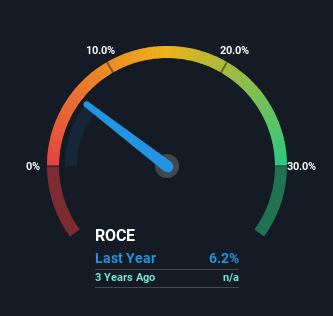- South Korea
- /
- Electrical
- /
- KOSDAQ:A199820
Returns On Capital Signal Difficult Times Ahead For Cheil Electric (KOSDAQ:199820)

Ignoring the stock price of a company, what are the underlying trends that tell us a business is past the growth phase? Typically, we'll see the trend of both return on capital employed (ROCE) declining and this usually coincides with a decreasing amount of capital employed. This indicates to us that the business is not only shrinking the size of its net assets, but its returns are falling as well. So after we looked into Cheil Electric (KOSDAQ:199820), the trends above didn't look too great.
Understanding Return On Capital Employed (ROCE)
Just to clarify if you're unsure, ROCE is a metric for evaluating how much pre-tax income (in percentage terms) a company earns on the capital invested in its business. Analysts use this formula to calculate it for Cheil Electric:
Return on Capital Employed = Earnings Before Interest and Tax (EBIT) ÷ (Total Assets - Current Liabilities)
0.062 = ₩7.9b ÷ (₩174b - ₩48b) (Based on the trailing twelve months to September 2023).
Thus, Cheil Electric has an ROCE of 6.2%. Ultimately, that's a low return and it under-performs the Electrical industry average of 8.3%.
View our latest analysis for Cheil Electric

While the past is not representative of the future, it can be helpful to know how a company has performed historically, which is why we have this chart above. If you'd like to look at how Cheil Electric has performed in the past in other metrics, you can view this free graph of Cheil Electric's past earnings, revenue and cash flow.
The Trend Of ROCE
In terms of Cheil Electric's historical ROCE movements, the trend doesn't inspire confidence. Unfortunately the returns on capital have diminished from the 11% that they were earning two years ago. And on the capital employed front, the business is utilizing roughly the same amount of capital as it was back then. Since returns are falling and the business has the same amount of assets employed, this can suggest it's a mature business that hasn't had much growth in the last two years. So because these trends aren't typically conducive to creating a multi-bagger, we wouldn't hold our breath on Cheil Electric becoming one if things continue as they have.
The Key Takeaway
All in all, the lower returns from the same amount of capital employed aren't exactly signs of a compounding machine. It should come as no surprise then that the stock has fallen 38% over the last three years, so it looks like investors are recognizing these changes. Unless there is a shift to a more positive trajectory in these metrics, we would look elsewhere.
Cheil Electric does have some risks though, and we've spotted 1 warning sign for Cheil Electric that you might be interested in.
If you want to search for solid companies with great earnings, check out this free list of companies with good balance sheets and impressive returns on equity.
New: AI Stock Screener & Alerts
Our new AI Stock Screener scans the market every day to uncover opportunities.
• Dividend Powerhouses (3%+ Yield)
• Undervalued Small Caps with Insider Buying
• High growth Tech and AI Companies
Or build your own from over 50 metrics.
Have feedback on this article? Concerned about the content? Get in touch with us directly. Alternatively, email editorial-team (at) simplywallst.com.
This article by Simply Wall St is general in nature. We provide commentary based on historical data and analyst forecasts only using an unbiased methodology and our articles are not intended to be financial advice. It does not constitute a recommendation to buy or sell any stock, and does not take account of your objectives, or your financial situation. We aim to bring you long-term focused analysis driven by fundamental data. Note that our analysis may not factor in the latest price-sensitive company announcements or qualitative material. Simply Wall St has no position in any stocks mentioned.
About KOSDAQ:A199820
Cheil Electric
Manufactures and sells electrical wiring equipment and related products in South Korea and internationally.
Excellent balance sheet with questionable track record.
Market Insights
Community Narratives




